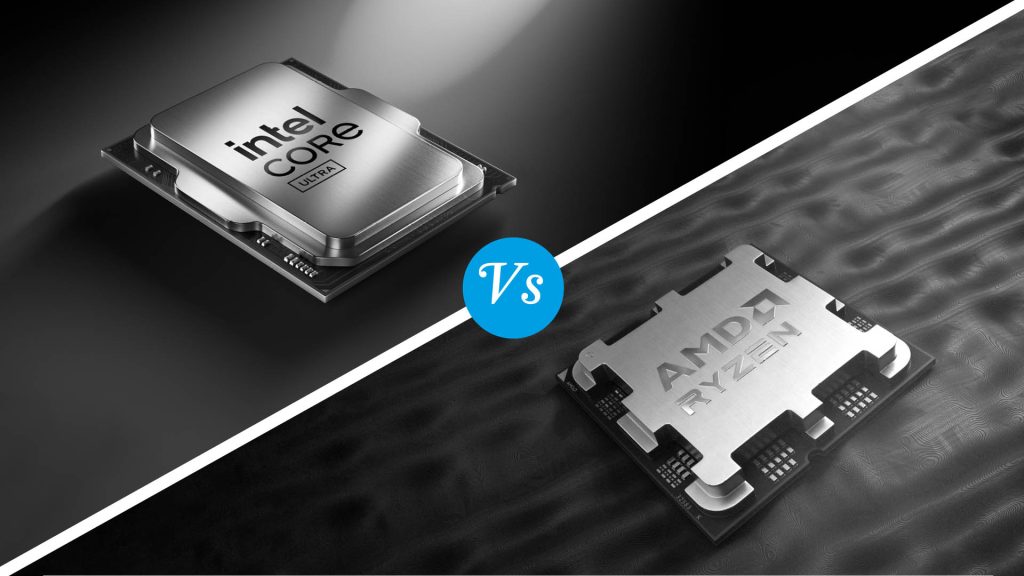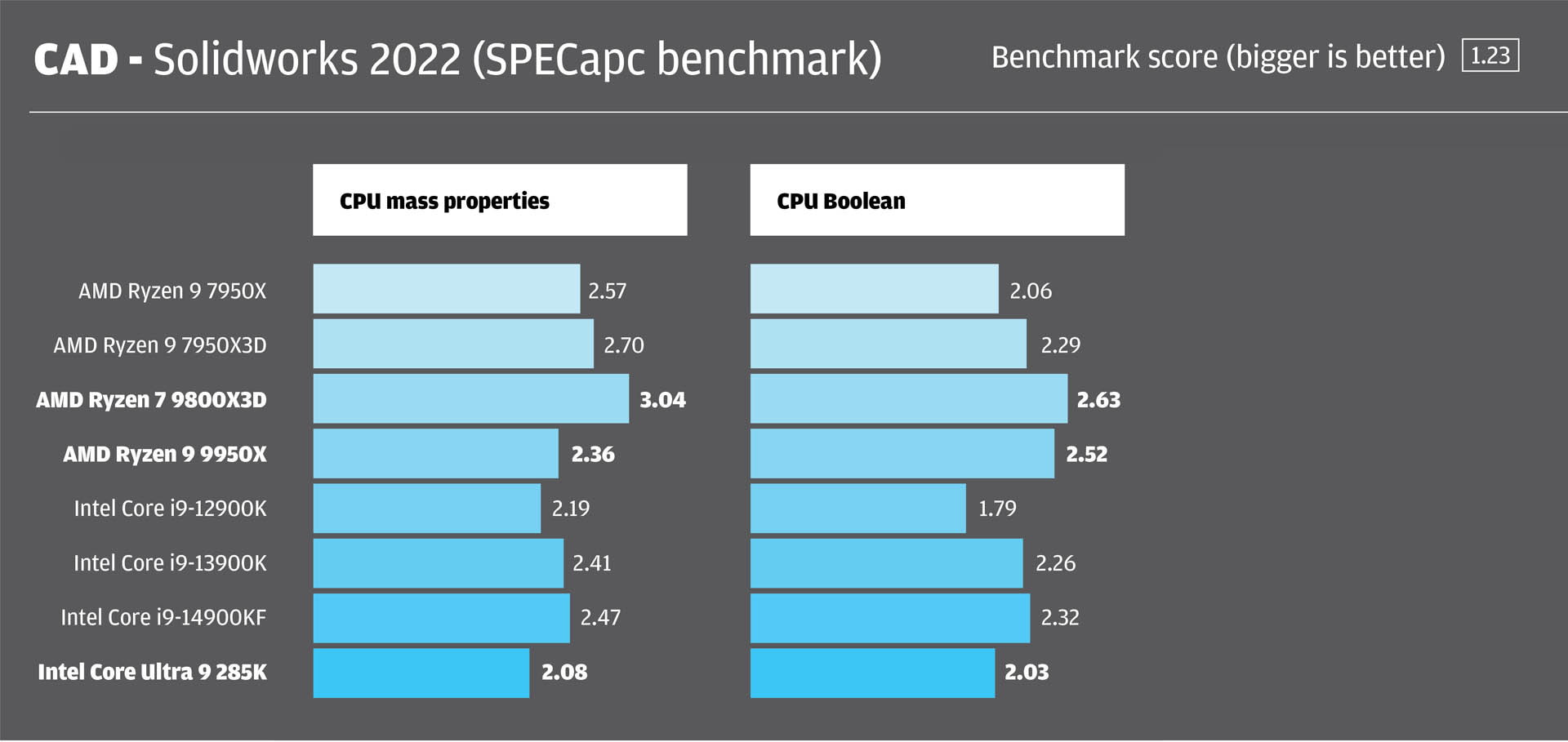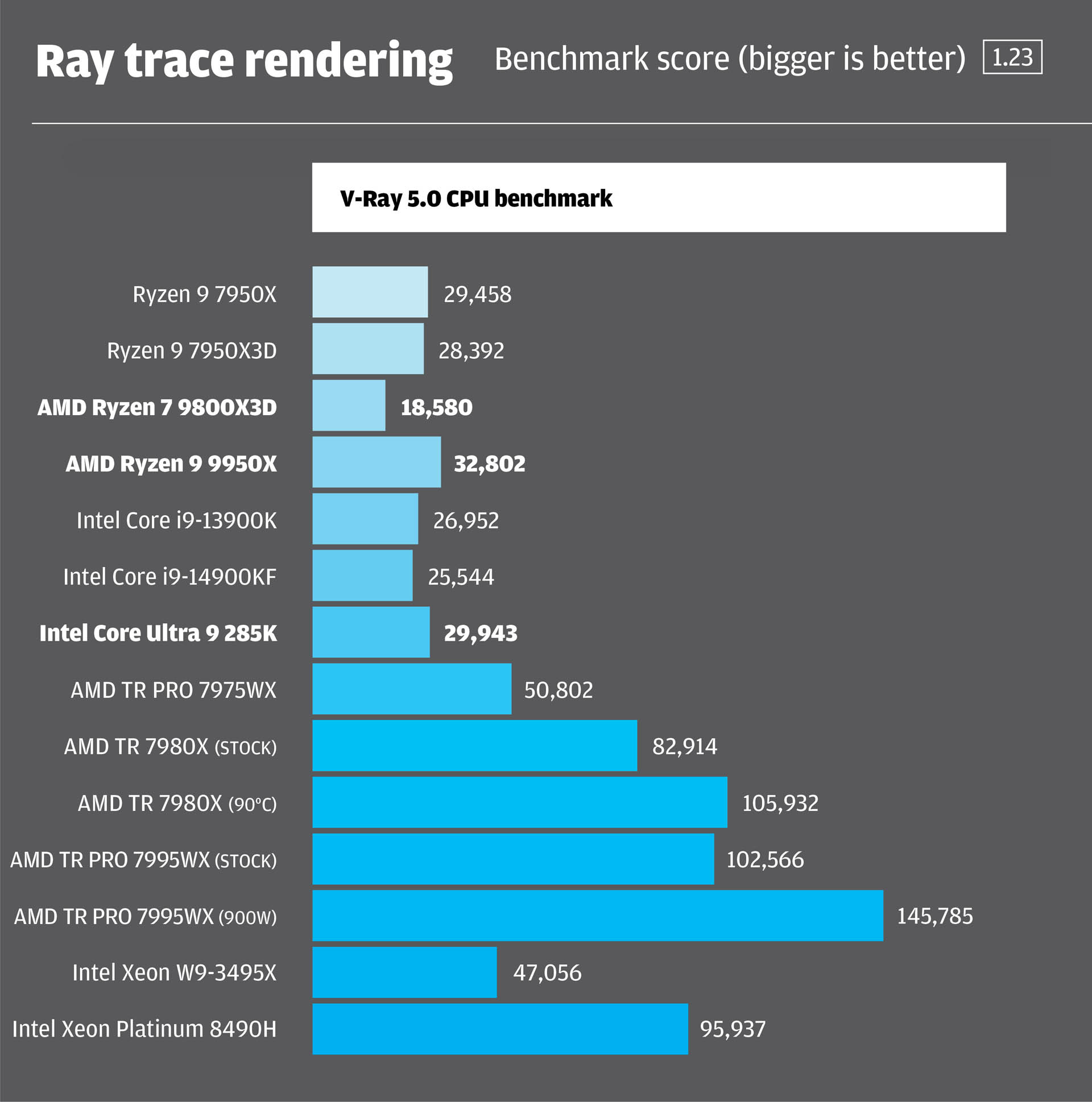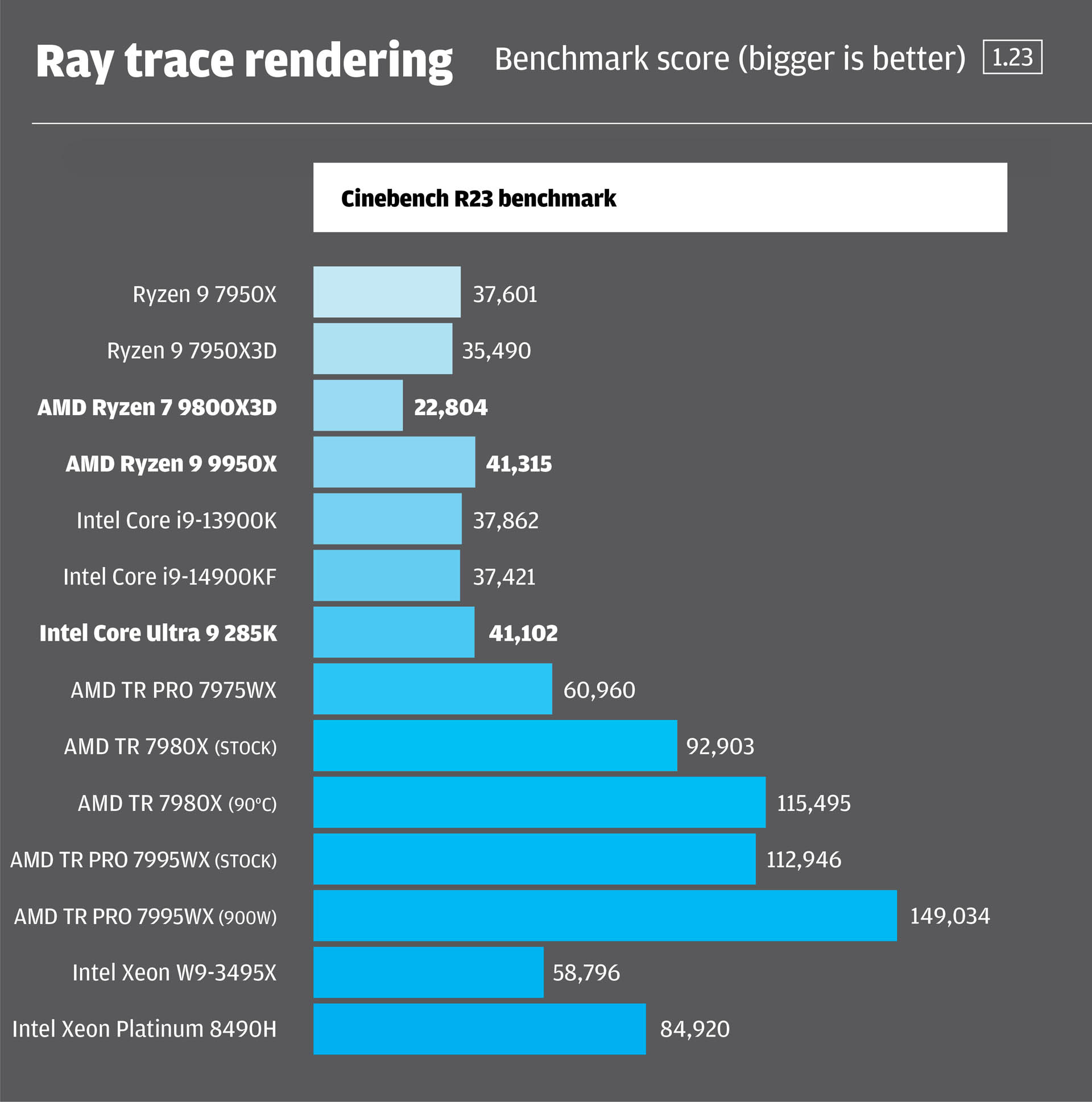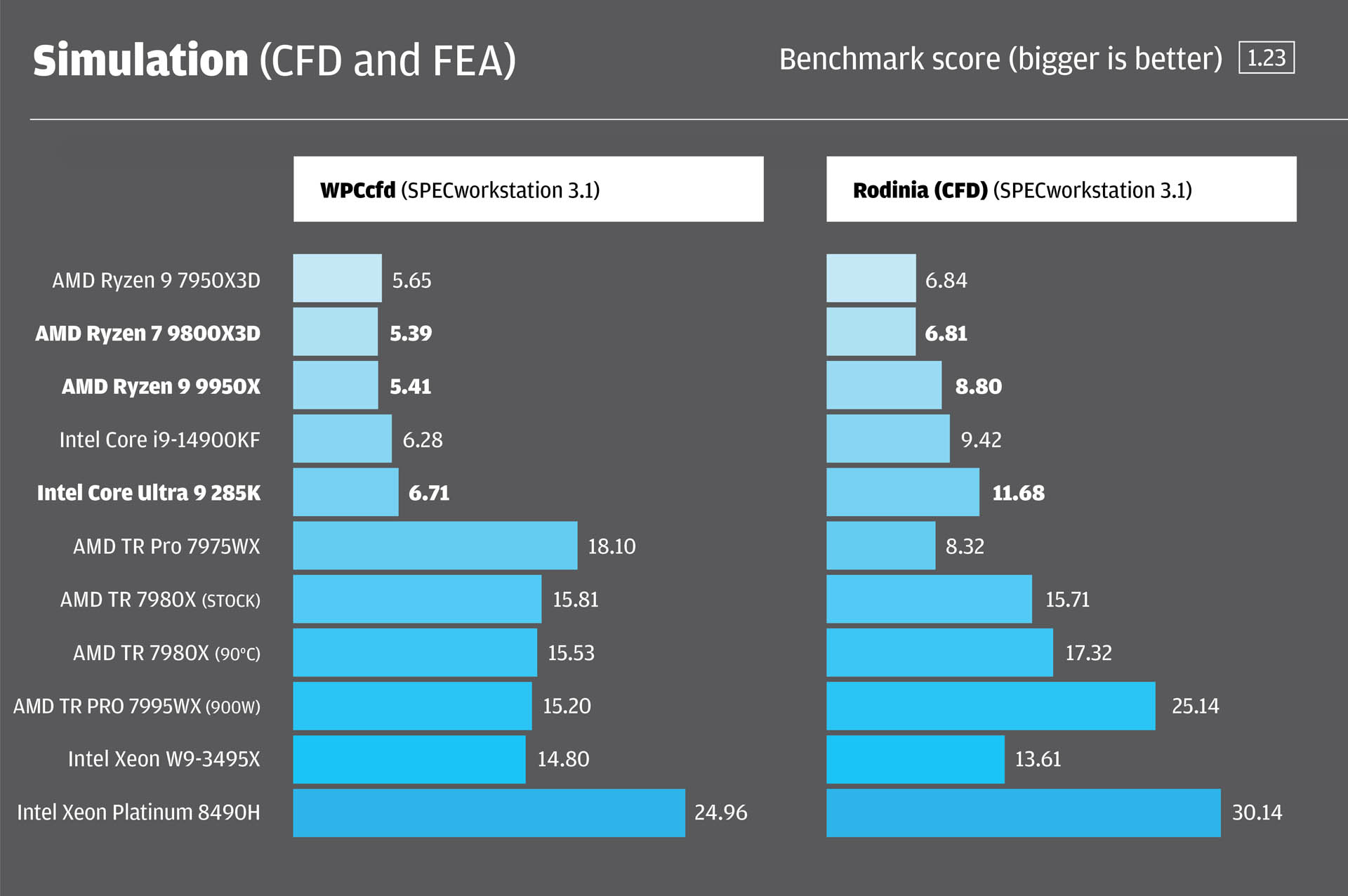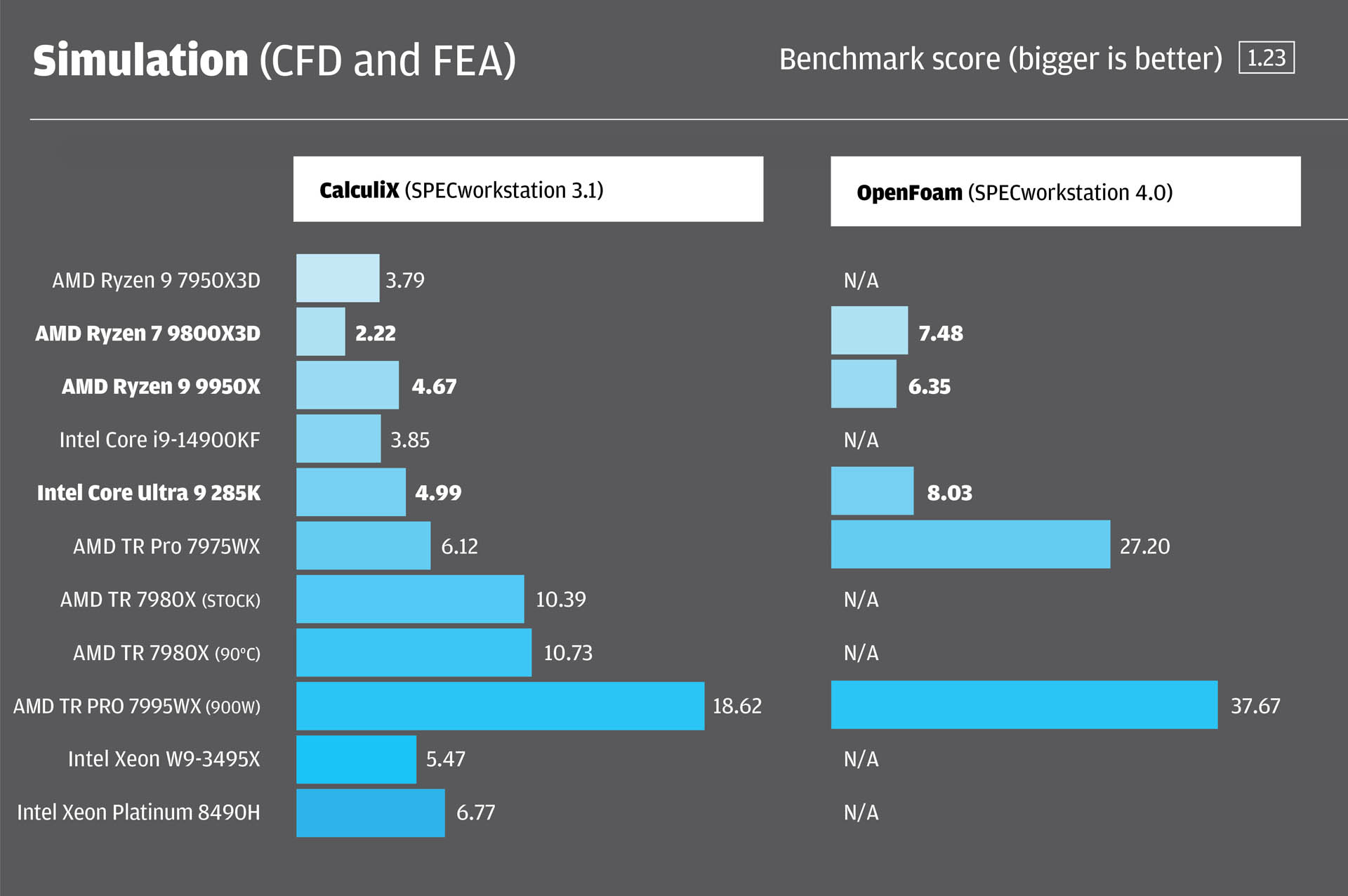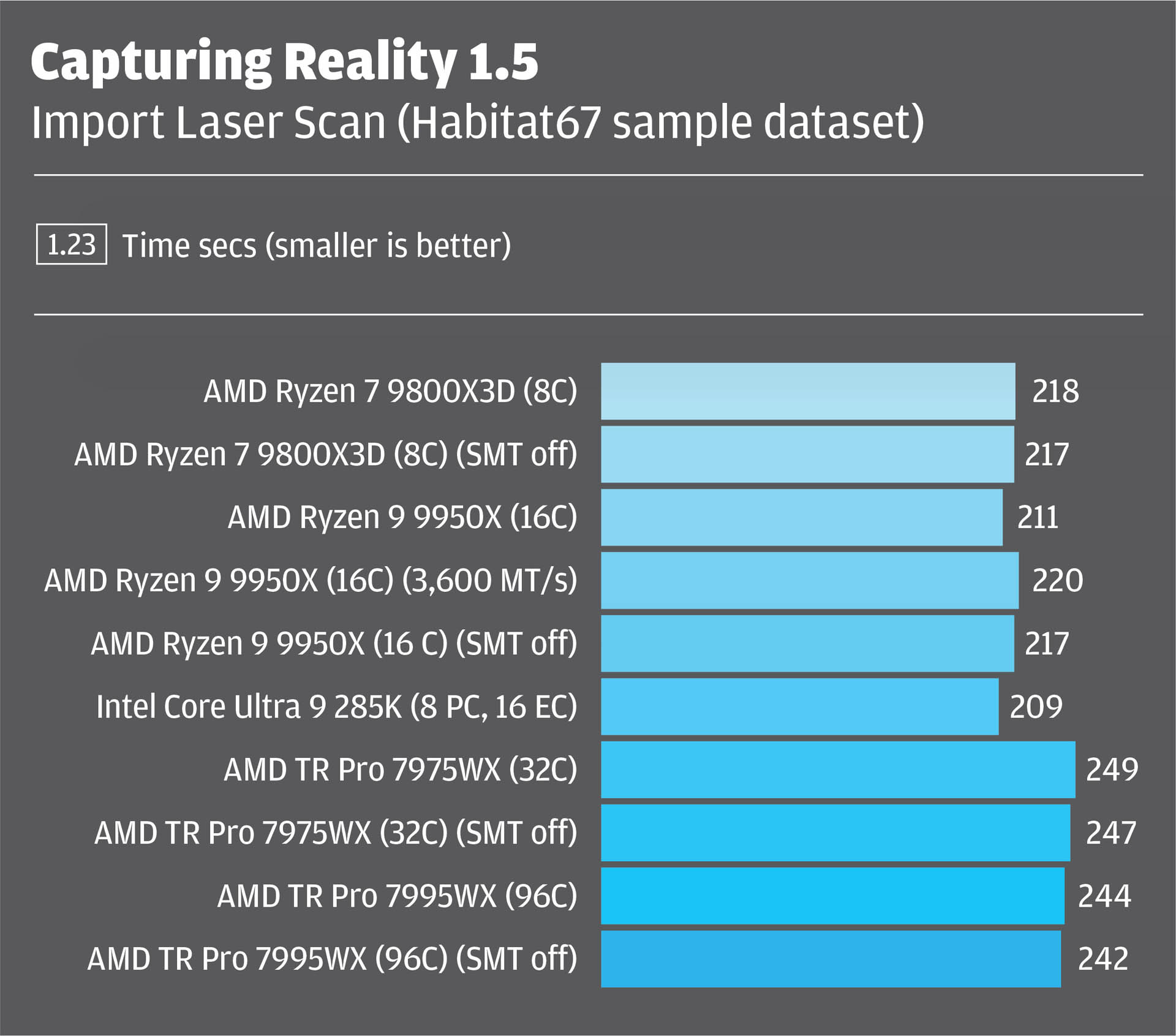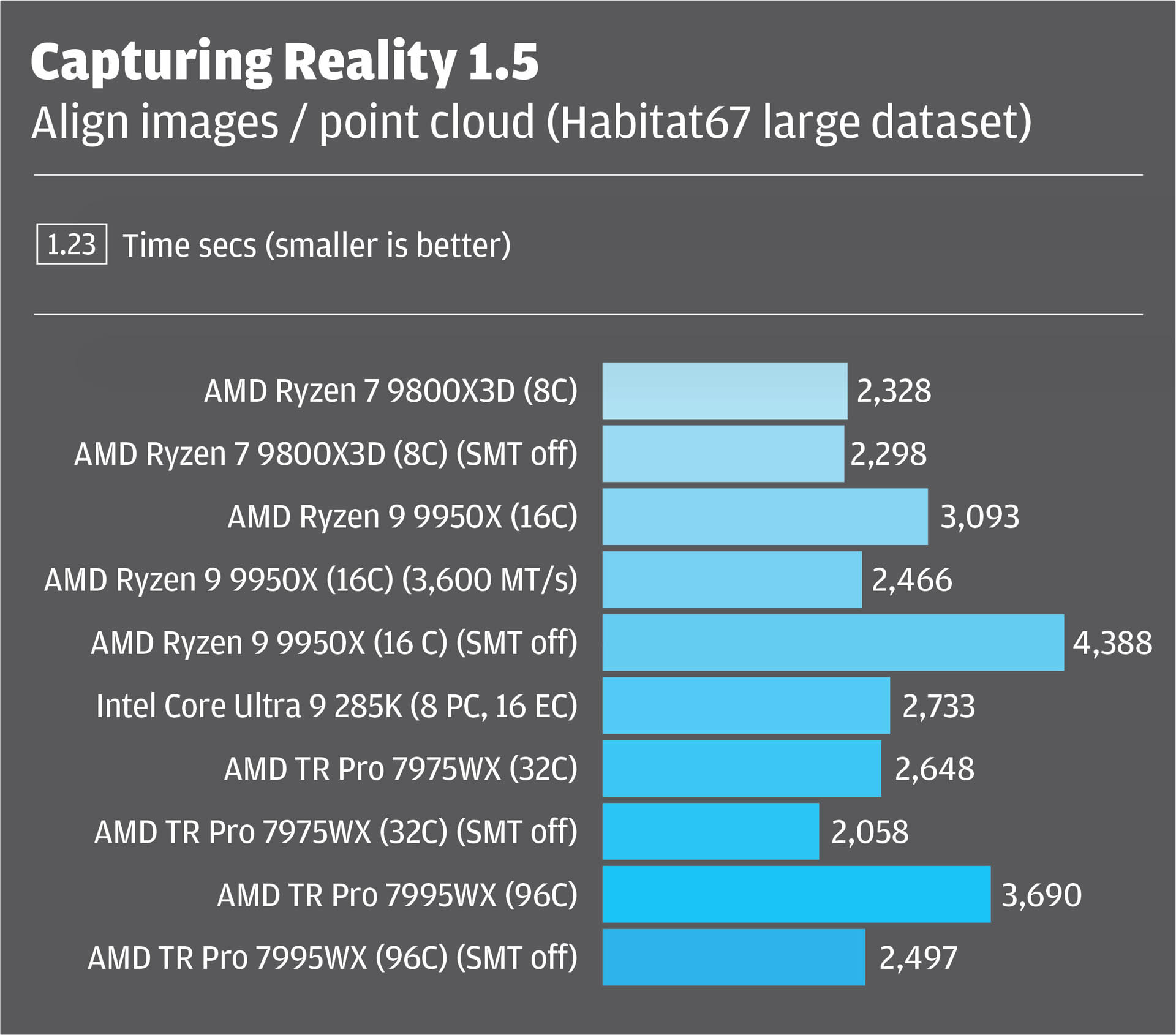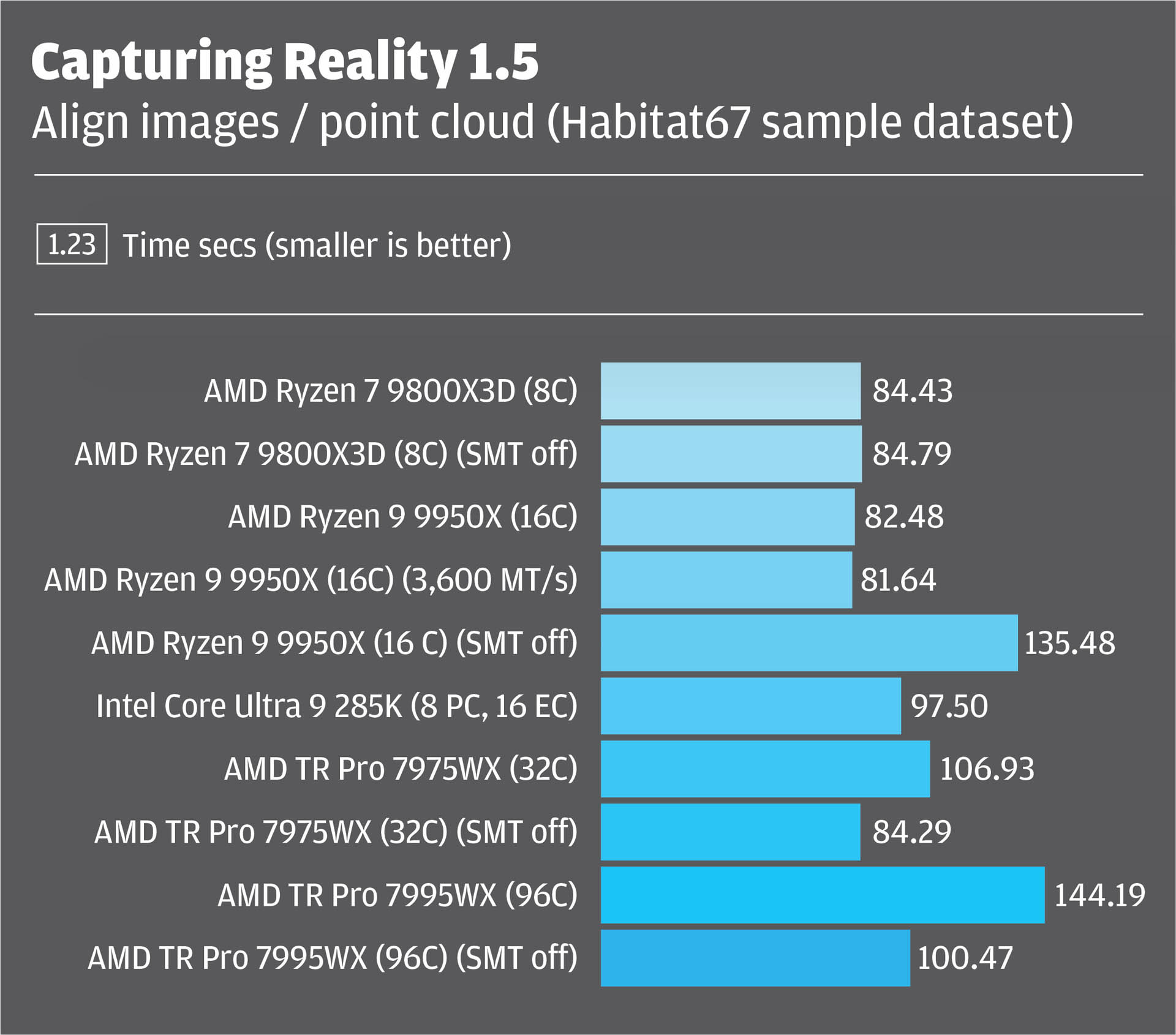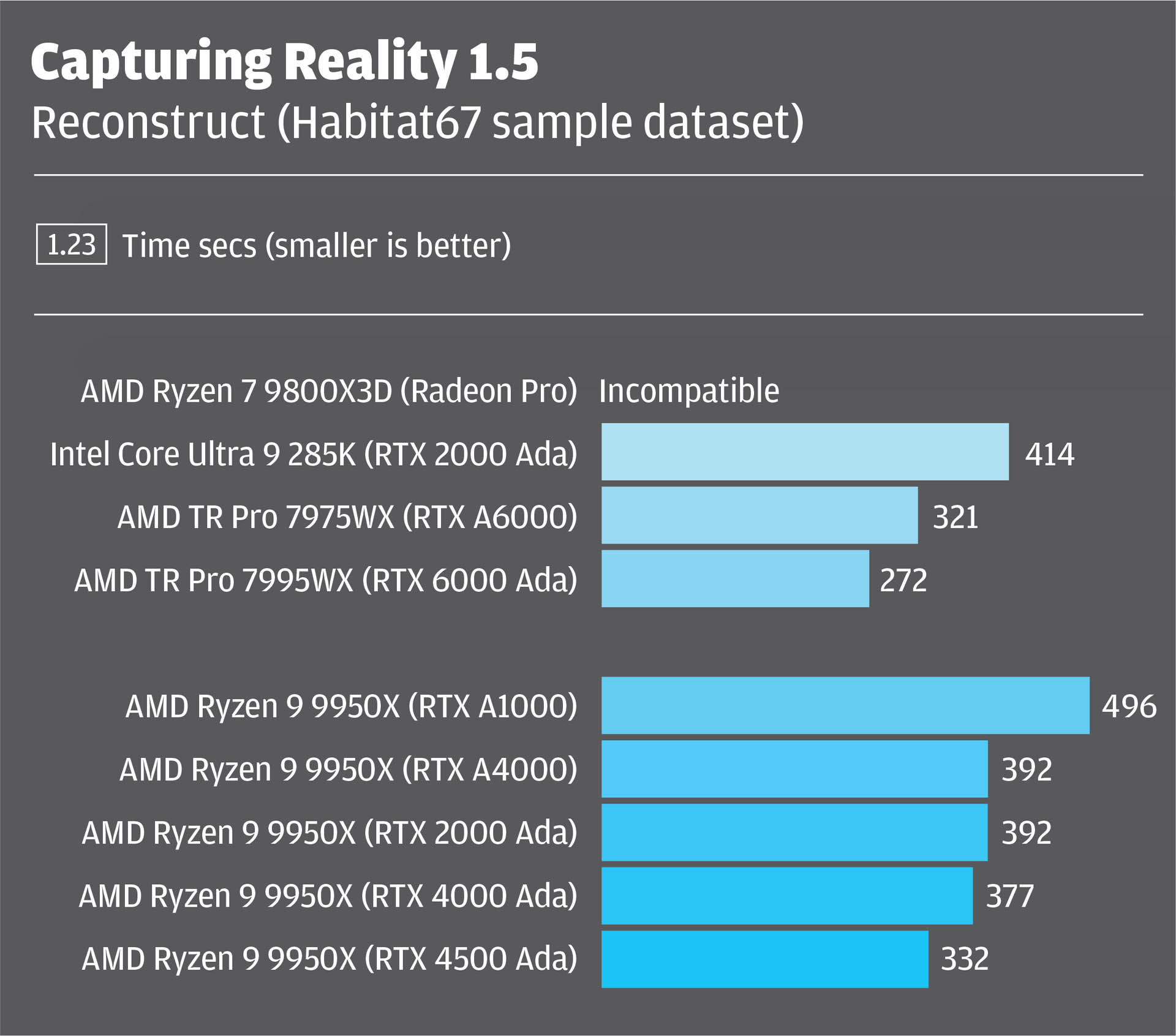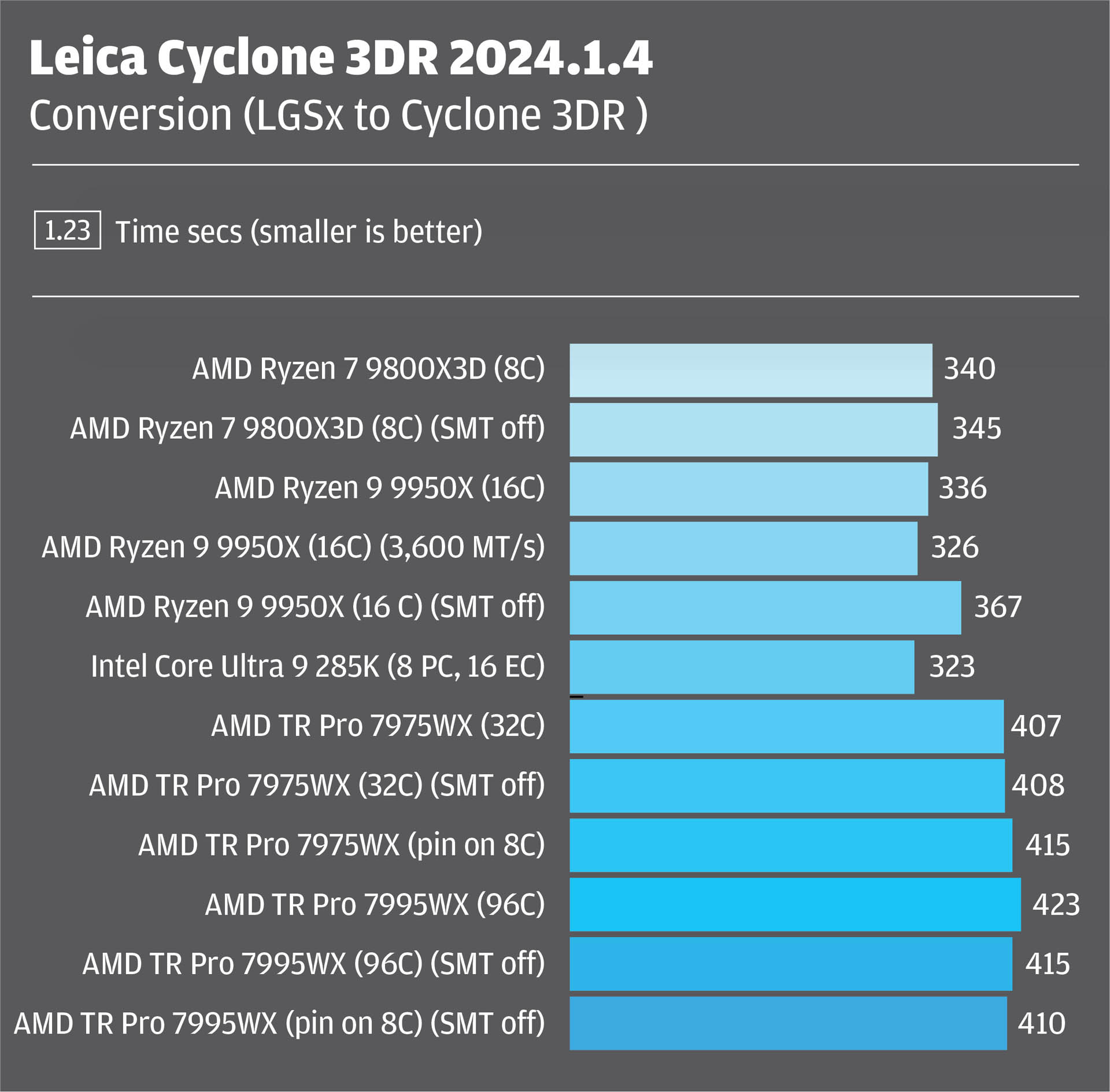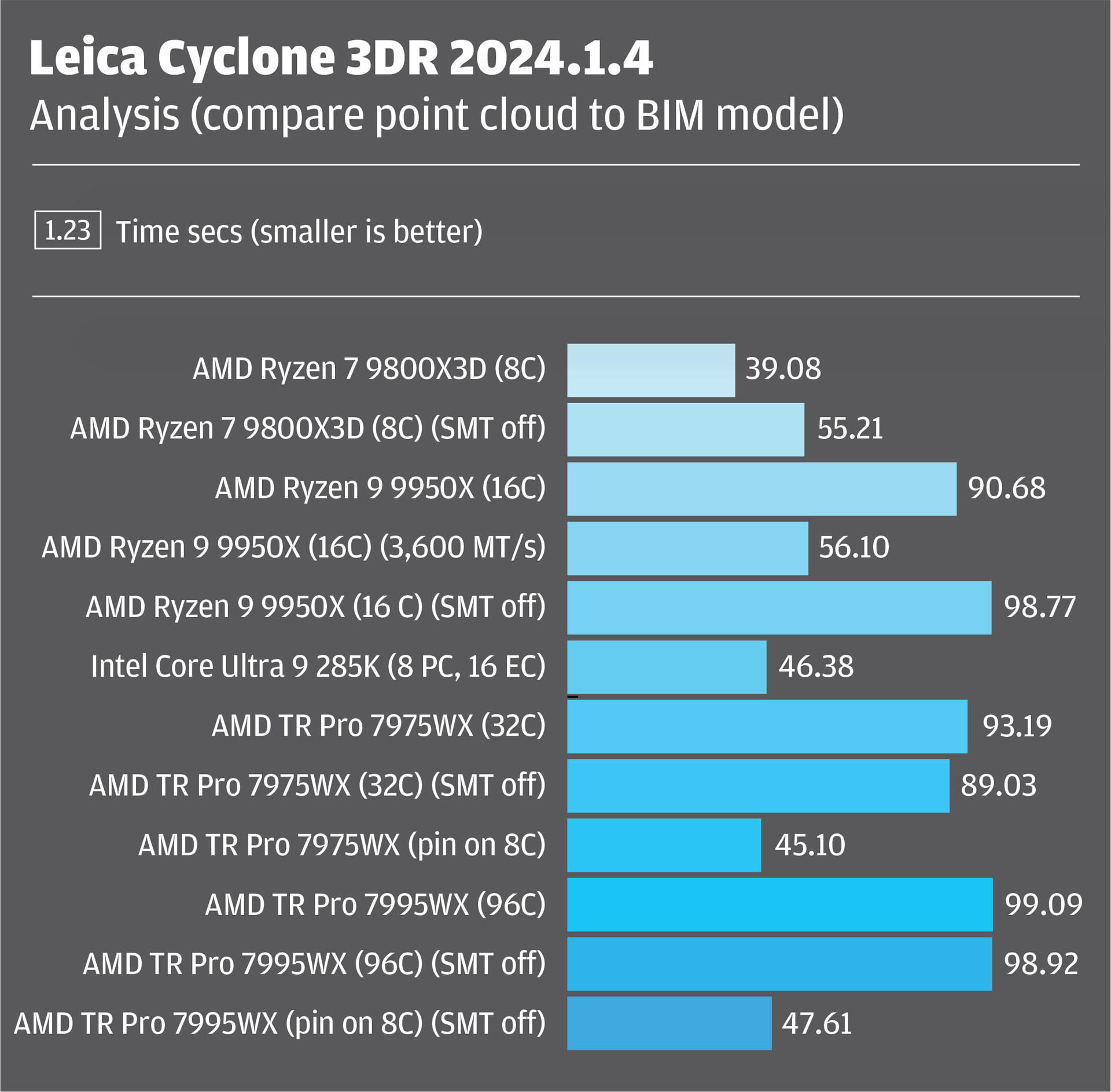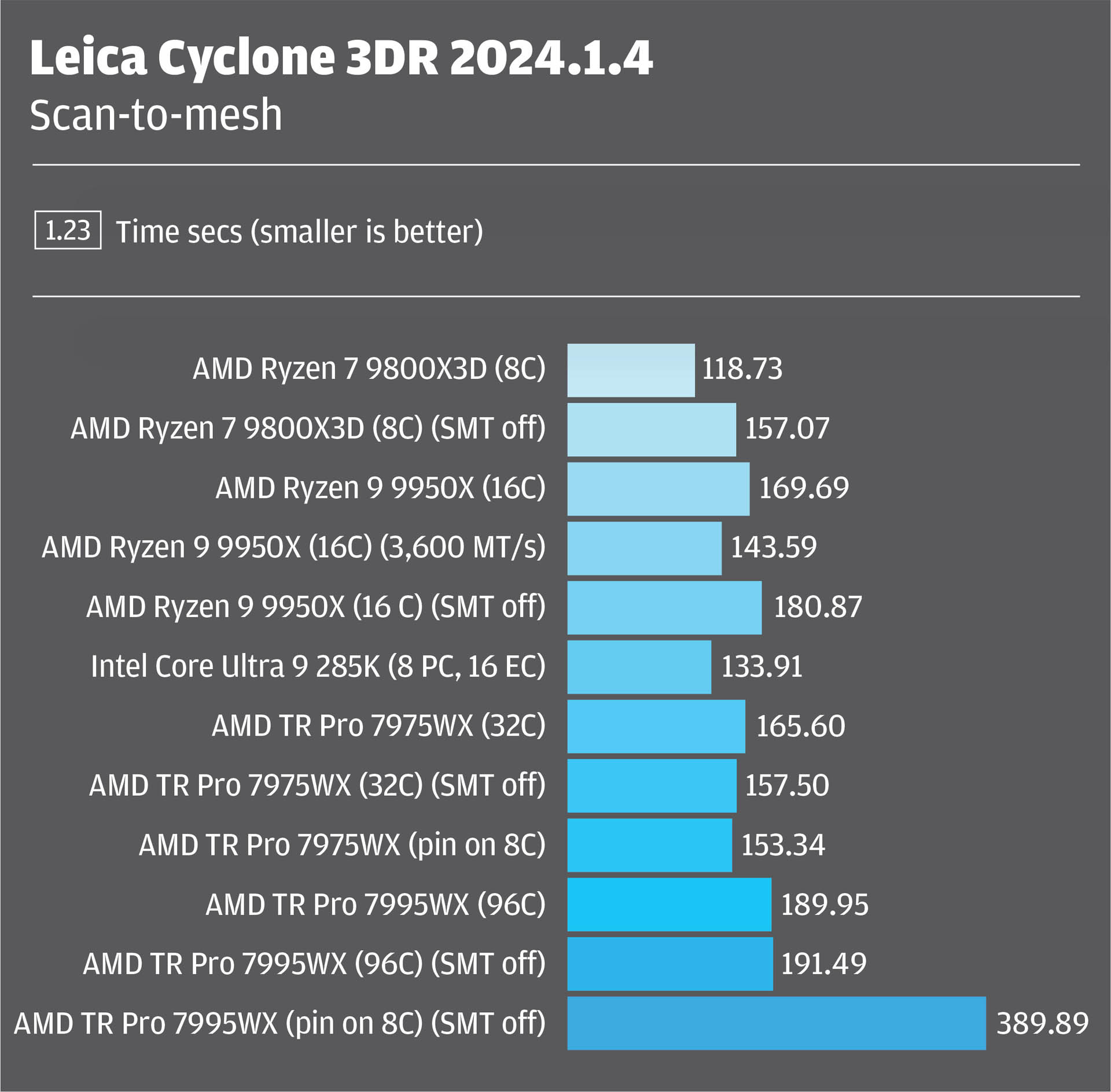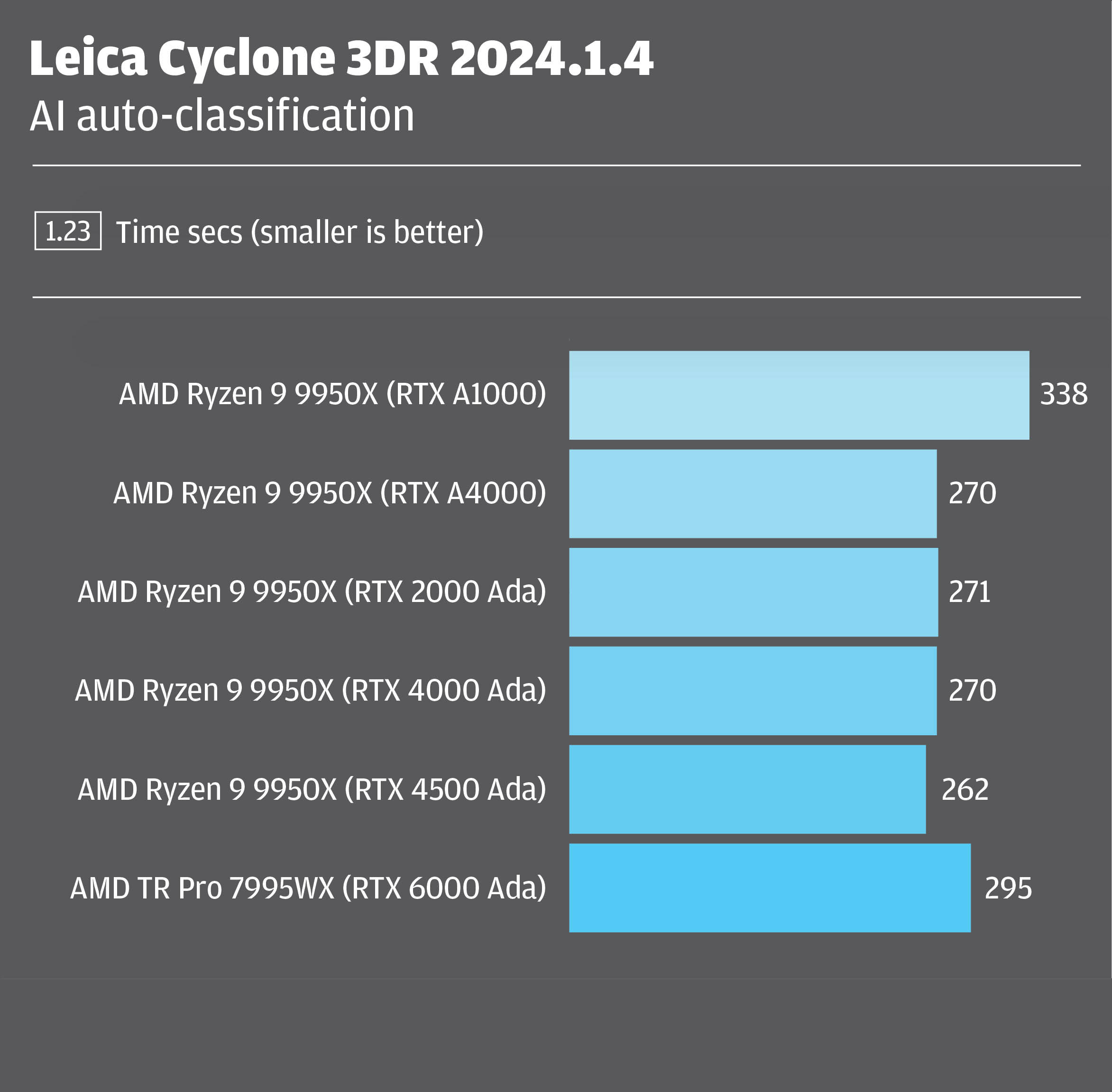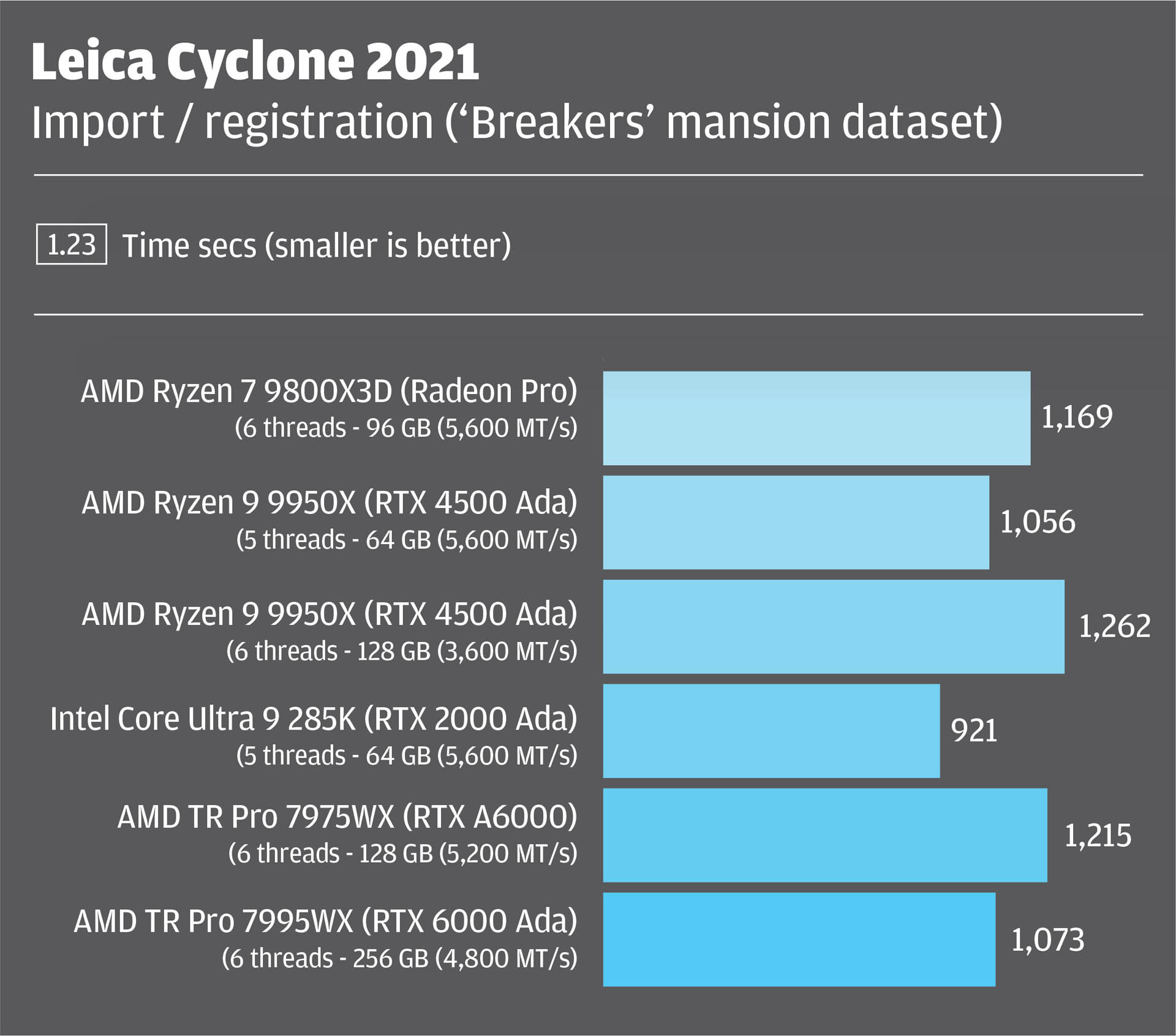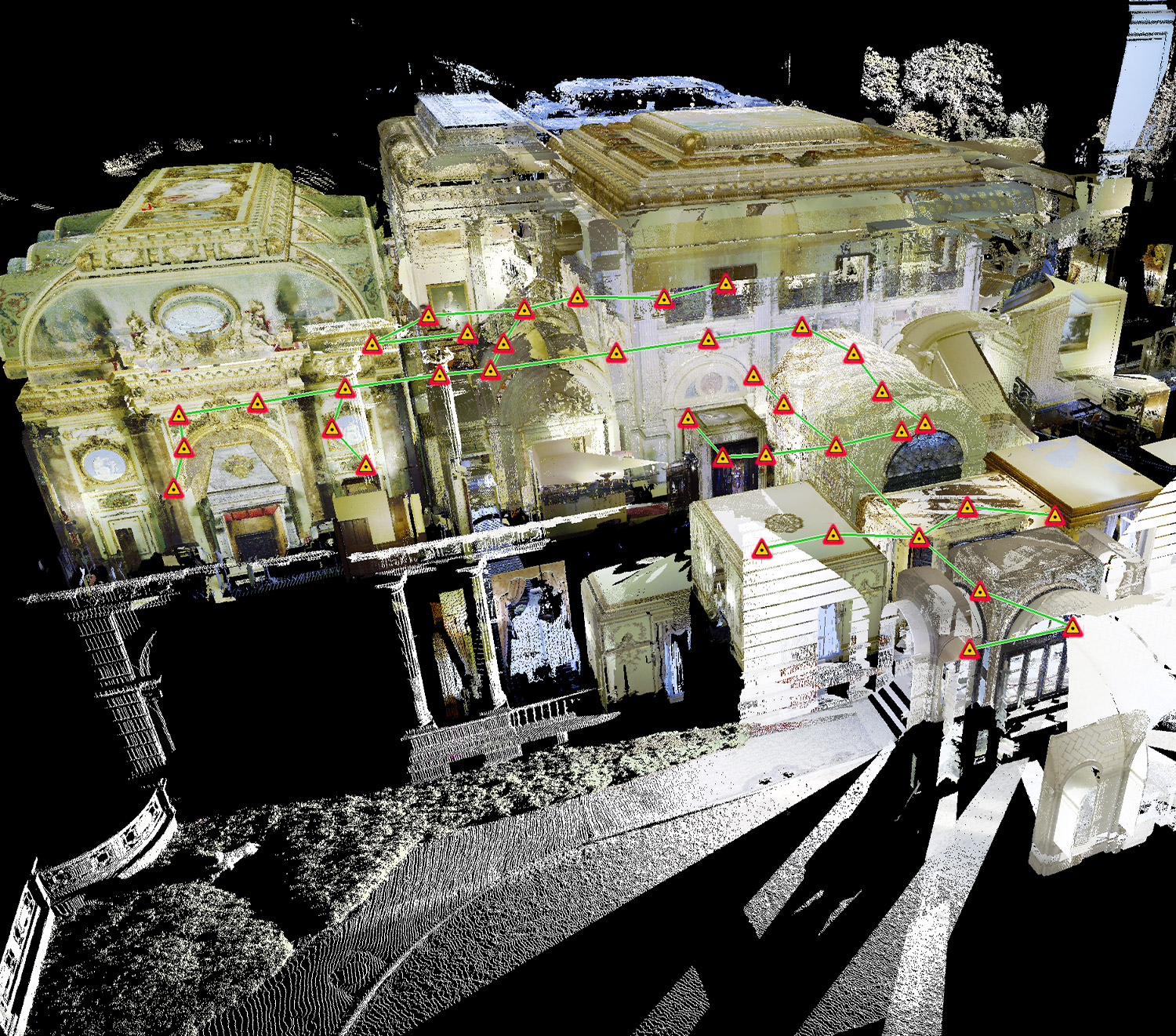AMD is dominating the high-end workstation market with Threadripper Pro. But how does it fare in the mainstream segment, a traditional stronghold for Intel? Greg Corke pits the AMD Ryzen 9000 Series against the Intel Core Ultra 200S to find out
After years of playing second fiddle, AMD is now giving Intel a serious run for its money. In high-end workstations, AMD Ryzen Threadripper Pro dominates Intel Xeon in most real-world benchmarks. The immensely powerful multi-core processor now plays a starring role in the portfolios of all the major workstation OEMs.
But what about the mainstream workstation market? Here, Intel has managed to maintain its dominance with Intel Core. Despite facing stiff competition from the past few generations of AMD Ryzen processors, none of HP, Dell nor Lenovo have backed AMD’s volume desktop chip with any real conviction.
This article is part of AEC Magazine’s 2025 Workstation Special report
That’s not the case with specialist workstation manufacturers, however. For some time now, AMD Ryzen has featured strongly in the portfolios of Boxx, Scan, Armari, Puget Systems and others.
But the silicon sector moves fast. Intel and AMD recently launched new mainstream processors — the AMD Ryzen 9000 Series and Intel Core Ultra 200S Series. Both chip families are widely available from specialist workstation manufacturers, which are much more agile when it comes to introducing new tech. We’ve yet to see any AMD Ryzen 9000 or Intel Core Ultra 200S Series workstations from the major OEMs. However, that’s to be expected as their preferred enterprise-focused variants — AMD Ryzen Pro and Intel Core vPro — have not launched yet.
With the ‘Zen 5’ AMD Ryzen 9000 Series, AMD is starting to take the lead in areas where Intel once ruled supreme
AMD Ryzen 9000 Series “Zen 5”
The AMD Ryzen 9000 Series desktop processors, built on AMD’s ‘Zen 5’ architecture, launched in the second half of 2024 with 6 to 16 cores. AMD continues to use a chiplet-based design, where multiple CCDs (Core Complex Dies) are connected together to form a single, larger processor. The 6 and 8-core models are made from a single CCD, while the 12 and 16-core models comprise two CCDs.
The new Ryzen processors continue to support simultaneous multi-threading (SMT), AMD’s equivalent to Intel HyperThreading, which enables a single physical core to execute multiple threads simultaneously. This can help boost performance in certain multi-threaded workflows, such as ray trace rendering, but it can also slow things down.
DDR5 memory is standard, up to a maximum of 192 GB. However, the effective data rate (speed) of the memory, expressed in mega transfers per second (MT/s), can vary dramatically depending on the amount of memory installed in your workstation. For example, you can currently get up to 96 GB at 5,600 MT/s, but if you configure the workstation with 128 GB, the speed will drop to 3,600 MT/s. Some motherboards can support even faster 8,000 MT/s memory, though this is currently limited to 48 GB.
All Ryzen 9000 Series processors come with integrated GPUs, but their performance is limited, making an add-in GPU essential for professional 3D work. They do not include an integrated neural processing unit (NPU) for AI tasks.
The Ryzen 9000 Series features two classes of processors: the standard Ryzen models, denoted by an X suffix and the Ryzen X3D variants which feature AMD 3D V-Cache technology.
There are four standard Ryzen 9000 Series models. The top-end AMD Ryzen 9 9950X has 16-cores, 32 threads, and a max boost frequency of 5.7 GHz.
AMD’s cache-rich Ryzen 9000 X3D variants look particularly appealing for select workflows where having superfast access to a large pool of frequently used data makes them shine
The other processors have slightly lower clock speeds and fewer cores but are considerably cheaper. The AMD Ryzen 5 9600X, for example, has six cores and boosts to 5.4 GHz, but is less than half the price of the Ryzen 9 9950X. The full line up can be seen in the table right.
The Ryzen X3D lineup features significantly larger L3 caches than standard Ryzen processors. This increased cache size gives the CPU fast access to more data, instead of having to fetch the data from slower system memory (RAM). The flagship 16-core AMD Ryzen 9 9950X3D features 128 MB of cache, but the 3D V-Cache is limited to one of its two CCDs.
All the new ‘Zen 5’ Ryzen 9000 chips are more power efficient than the previous generation ‘Zen 4’ Ryzen 7000 Series. This has allowed AMD to reduce the Thermal Design Power (TDP) on a few of the standard Ryzen models. The top-end 16-core processors — the Ryzen 9 9950X and Ryzen 9 9950X3D — both have a TDP of 170W and a peak power of 230W. All the others are rated at 65W or 120W.
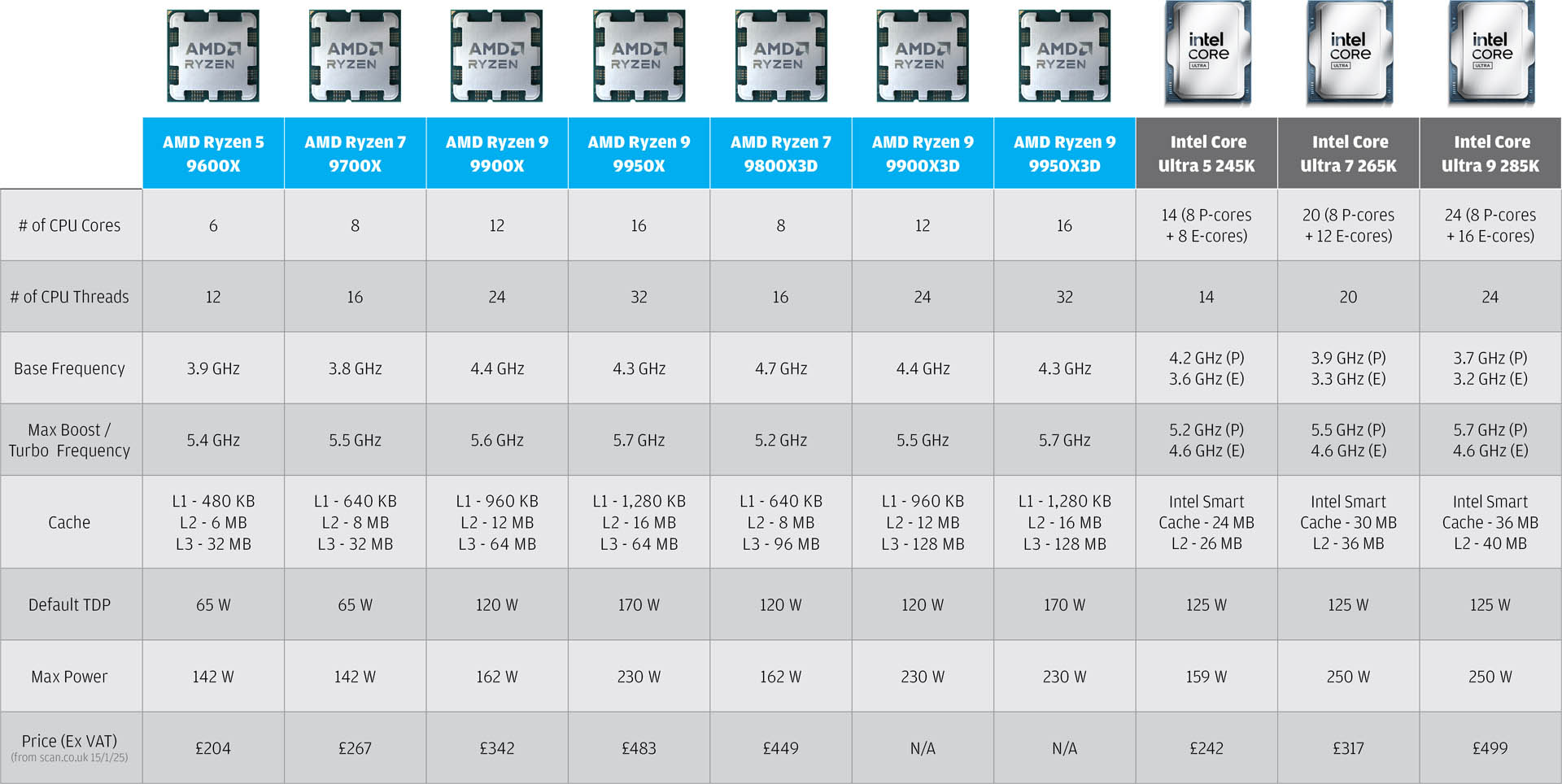
Intel Core Ultra 200S “Arrow Lake”
Intel Core Ultra marks a departure from Intel’s traditional generational numbering system (e.g., 14th Gen). But the Intel Core Ultra 200S (codenamed Arrow Lake) is not just an exercise in branding. It marks a major change in the design of its desktop processors, moving to a tiled architecture (Intel’s term for chiplets).
Like 14th Gen Intel Core, the Intel Core Ultra 200S features two different types of cores: Performance-cores (P-cores) for primary tasks and slower Efficient-cores (E-cores) for background processing.
In a bold move, Intel has dropped Hyper-Threading from the design, a feature that was previously supported on the P-cores in 14th Gen Intel Core.
Like AMD, DDR5 memory is standard, with a maximum capacity of 192 GB. However, the data rate doesn’t vary as much depending on the amount installed. For instance, with 64 GB, the speed reaches 5,600 MT/s, while with 128 GB, it only drops slightly to 4,800 MT/s.
The integrated GPU has been improved, but most 3D workflows will still require an add-in GPU. For AI tasks, there’s an integrated NPU, but at 13 TOPS it’s not powerful enough to meet Microsoft’s requirements for Windows Copilot+.
The processor family includes three main models. At the high end, the Intel Core Ultra 9 285K features 8 P-cores and 16 E-cores. The P-cores operate at a base frequency of 3.7 GHz, with a maximum Turbo of 5.7 GHz. It has a base power of 125 W and draws 250 W at peak.
At the entry level, the Intel Core Ultra 5 245K offers 6 P-cores and 8 E-cores, with a base frequency of 4.2 GHz and a max Turbo of 5.2 GHz. It has a base power of 125 W, rising to 159 W under Turbo. The full lineup is detailed further up the page.
Test setup
For our testing, we focused on the flagship models from each standard processor family: the AMD Ryzen 9 9950X (16 cores, 32 threads) and the Intel Core Ultra 9 285K (8 P-cores, 16 E-cores). We also included the AMD Ryzen 7 9800X3D (8 cores, 16 threads) which, at the time, was the most powerful Ryzen 9000 Series chip with 3D V-Cache. At CES a few weeks ago, AMD announced the 12-core Ryzen 9 9900X3D and the 16-core Ryzen 9 9950X3D but these 3D V-Cache processors were not available for testing.
The AMD Ryzen 9 9950X and Intel Core Ultra 9 285K were housed in very similar workstations — both from specialist UK manufacturer, Scan. Apart from the CPUs and motherboards, the other specifications were almost identical.
The AMD Ryzen 7 9800X3D workstation came from Armari. All machines featured different GPUs, but our tests focused on CPU processing, so this shouldn’t impact performance. The full specs can be seen below. Testing was done on Windows 11 Pro 26100 with power plan set to high-performance.
AMD Ryzen 9 9950X
Scan 3XS GWP-A1-R32 workstation (See review)
• Motherboard: Asus Pro Art B650 Creator
• Memory: 64 GB (2 x 32 GB) Corsair DDR5 (5,600 MT/s)
• GPU: Nvidia RTX 4500 Ada Gen
• Storage: 2TB Corsair MP700 Pro SSD
• Cooling: Corsair Nautilus 360 cooler
• PSU: Corsair RM750e PSU
Intel Core Ultra 9 285K
Scan 3XS GWP-A1-C24 workstation (See review)
• Motherboard: Asus Prime Z890-P
• Memory: 64 GB (2 x 32 GB) Corsair DDR5 (5,600 MT/s)
• GPU: Nvidia RTX 2000 Ada Gen
• Storage: 2TB Corsair MP700 Pro SSD
• Cooling: Corsair Nautilus 360 cooler
• PSU: Corsair RM750e PSU AMD Ryzen 7 9800X3D
AMD Ryzen 7 9800X3D
Armari Magnetar MM16R9 workstation (See review)
• Motherboard: ASUS ROG Strix AMD B650E-I Gaming WiFi Mini-ITX |
• Memory: 96 GB (2 x 48 GB) Corsair Vengeance DDR5-6000C30 EXPO (5,600 MT/s)
• GPU: AMD Radeon Pro W7500
• Storage: 2TB Samsung 990 Pro SSD
• Cooling: Armari SPX-A6815NGR 280mm AIO+NF-P14 redex
• PSU: Thermaltake Toughpower SFX 850W ATX3.0 Gen5
On test
We tested all three workstations with a range of real-world applications used in AEC and product development. Where data existed, and was relevant, we also compared performance figures from older generation processors. This included mainstream models (12th, 13th and 14th Gen Intel Core, AMD Ryzen 7000) and high-end workstation processors (AMD Ryzen 7000 Threadripper and Threadripper Pro, Intel Xeon W-3400, and 4th Gen Intel Xeon Scalable).
Data for AMD Threadripper came from standard and overclocked workstations. In the benchmark charts, 90°C refers to the max temp set in the Armari Magnetar M64T7 ‘Level 1’ PBO (see Workstation Special Report 2024), while 900W refers to power draw of the processor in the Comino Grando workstation (read our review).
The comparisons aren’t entirely apples-to-apples — older machines were tested with different versions of Windows 11, as well as varying memory, storage, and cooling configurations. However, the results should still provide a solid approximation of relative performance.
CAD and BIM
Dassault Systèmes Solidworks (CAD) and Autodesk Revit (BIM) are bread and butter tools for designers, engineers, and architects. For the most part, these applications are single-threaded, although some processes are able to utilise a few CPU cores. Ray-trace rendering stands out as the exception, taking full advantage of all available cores.
In the Autodesk Revit 2025 RFO v3 benchmark the AMD Ryzen 9 9950X came out top in the model creation and export tests, in which Intel has traditionally held an edge. The AMD Ryzen 7 9800X3D performed respectably, but with its slightly lower maximum frequency, lagged behind a little.
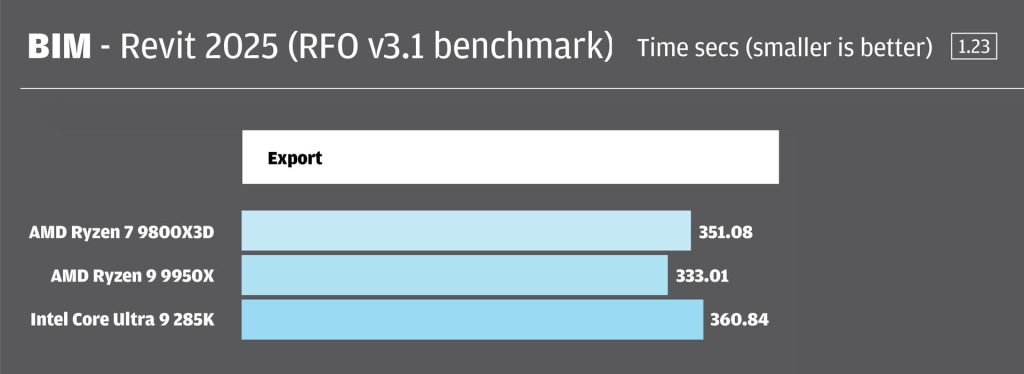
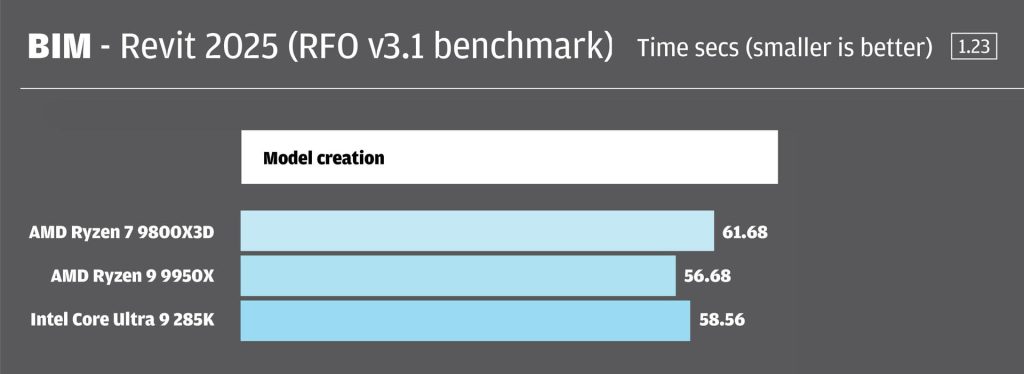
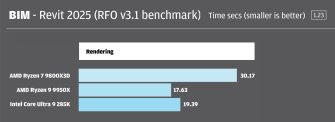
In Solidworks 2022, things were much more even. In the rebuild, convert, and simulate subtests of the SPECapc benchmark, there was little difference between the AMD Ryzen 9 9950X and the Intel Core Ultra 9 285K. However, in the mass properties and boolean subtests, the Ryzen 9 9950X pulled ahead, only to be outshined by the Ryzen 7 9800X3D. Despite the 9800X3D having a lower clock speed, it looks like the additional cache provides a significant performance boost.
But how do the new chips compare to older generation processors? Our data shows that while there are improvements, the performance gains are not huge.
AMD’s performance increases ranged from 7% to 22% generation-on-generation, although the Ryzen 9 9950X was 9% slower in the mass properties test. Intel’s improvements were more modest, with a maximum gain of just 9%. In fact, in three tests, the Intel Core Ultra 9 285K was up to 19% slower than its predecessor.
Looking back over the last three years, Intel’s progress appears incremental. Compared to the Intel Core i9-12900K, launched in late 2021, the Intel Core Ultra 9 285K is only up to 26% faster.
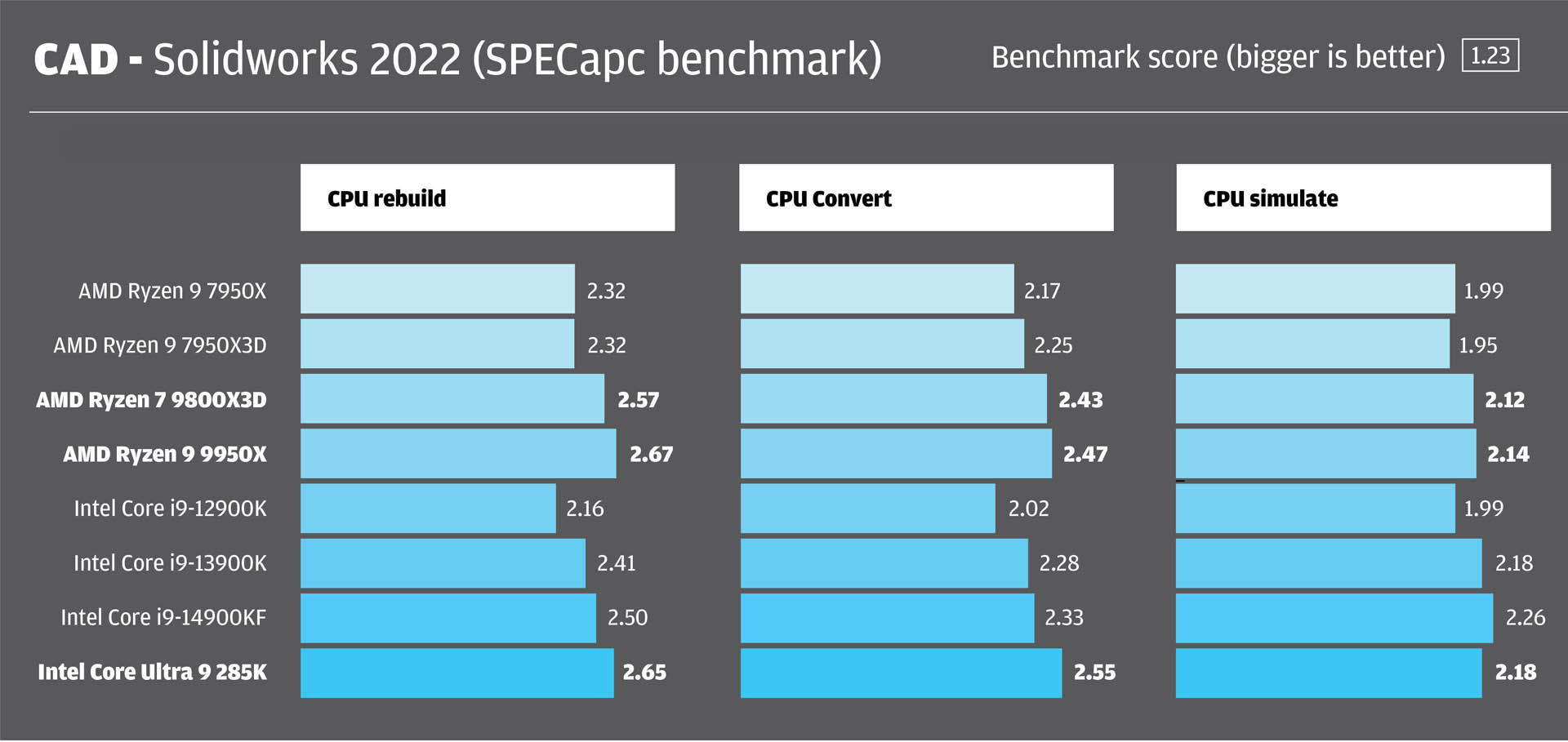
Ray trace rendering
Ray trace rendering is exceptionally multithreaded, so can take full advantage of all CPU cores. Unsurprisingly, the processors with the highest core counts — the AMD Ryzen 9 9950X (16 cores) and Intel Core Ultra 9 285K (24 cores) — topped our tests.
The Ryzen 9 9950X outperformed the Intel Core Ultra 9 285K in several benchmarks, delivering faster performance in V-Ray (17%), CoronaRender (15%), and KeyShot (11%). Intel’s decision to drop Hyper-Threading may have contributed to this performance gap, though Intel still claimed a slight lead in Cinebench, with a 5% advantage.
Gen-on-gen improvements were modest. Intel showed gains of 4% to 17%, while AMD delivered between 5% and 11% faster performance.
We also ran stress tests to assess sustained performance. In several hours of rendering in V-Ray, the Ryzen 9 9950X held steady at 4.91 GHz, while the Ryzen 9 9800X3D maintained 5.17 GHz. Meanwhile, the P-cores of the Intel Core Ultra 9 285K reached 4.86 GHz.
Power consumption is another important consideration. The Ryzen 9 9950X drew 200W, whereas the Intel Core Ultra 9 285K peaked at 240W — slightly lower than its predecessor, 14th Gen Intel Core.
Since rendering scales exceptionally well with higher core counts, the best performance is achieved with high-end workstation processors like AMD Ryzen Threadripper Pro.
Simulation (FEA and CFD)
Engineering simulation encompasses Finite Element Analysis (FEA) and Computational Fluid Dynamics (CFD), both of which are extremely demanding computationally.
FEA and CFD utilise a variety of solvers, each with unique behaviours, and performance can vary depending on the dataset. Generally, CFD scales well with additional CPU cores, allowing studies to solve significantly faster. Moreover, CFD performance benefits greatly from higher memory bandwidth, making these factors critical for optimal results.
For our testing, we selected three workloads from the SPECworkstation 3.1 benchmark and one from SPECworkstation 4.0. The CFD tests included Rodinia (representing compressible flow), WPCcfd (modelling combustion and turbulence), and OpenFoam with XiFoam solver. For FEA, we used CalculiX, which simulates the internal temperature of a jet engine turbine.
The Intel Core Ultra 9 285K claimed the top spot in all the tests. The AMD Ryzen 9 9950X followed in second place, except in the OpenFoam benchmark, where it was outperformed by the Ryzen 9 9800X3D— likely due to the additional cache.
Of course, for those deeply invested in simulation, high-end workstation processors, such as AMD Ryzen Threadripper Pro and Intel Xeon offer a significant advantage, thanks to their higher core counts and superior memory bandwidth. For a deeper dive, check out last year’s workstation special report.
Reality modelling
Reality modelling is becoming prevalent in the AEC sector. Raw data captured by drones (photographs / video) and terrestrial laser scanners must be turned in point clouds and reality meshes — a process that is very computationally intensive.
We tested a range of workflows using three popular tools: Leica Cyclone 3DR, Leica Cyclone Register 360, and RealityCapture by Capturing Reality, a subsidiary of Epic Games.
As many of the workflows in these applications are multi-threaded, we were surprised that the 8-core AMD Ryzen 9800X3D outperformed the 16-core AMD Ryzen 9950X and 24-core Intel Core Ultra 9 285K in several tests. This is likely due to its significantly larger cache, but possibly down to its single CCD design, which houses all 8 CPU cores.
In contrast, the 16-core AMD Ryzen 9950X, which is made up of two 8-core CCDs, may suffer from latency when cores from different CCDs need to communicate with each other. It will be interesting to see how the recently announced 12-core Ryzen 9 9900X3D and 16-core Ryzen 9 9950X3D compare.
The other point worth noting is the impact of memory speed. In some workflows we experienced dramatically faster computation with faster memory. Simultaneous multi-threading (SMT) also had an impact on performance.
We explore reality modelling in much more detail in this in-depth article.
The verdict
For the past few years, Intel and AMD have been battling it out in the mainstream processor market. Intel has traditionally dominated single threaded and lightly threaded workflows like CAD, BIM, and reality modelling, while AMD has been the go-to choice for multithreaded rendering.
But the landscape is shifting. With the ‘Zen 5’ AMD Ryzen 9000 Series, AMD is starting to take the lead in areas where Intel once ruled supreme. For instance, in Solidworks CAD, AMD is delivering solid generation-on-generation performance improvements, while Intel appears to be stagnating. In fact, some workflows show the Intel Core Ultra 200S trailing behind older 14th Gen Intel Core processors.
That said, for most workstation users, AMD’s rising stock won’t mean much unless major OEMs like Dell, HP, and Lenovo start giving Ryzen the same level of attention they’ve devoted to AMD Ryzen Threadripper Pro. A lot will depend on AMD releasing Pro variants of the Ryzen 9000 Series to meet the needs of enterprise users.
For everyone else relying on specialist manufacturers, workstations with the latest Intel and AMD chips are already available. This includes AMD’s cache-rich Ryzen 9000 X3D variants, which look particularly appealing for select workflows where having superfast access to a large pool of frequently used data makes them shine.
This article is part of AEC Magazine’s 2025 Workstation Special report
- Features
- AMD Ryzen AI Max Pro: the integrated GPU comes of age
- AMD Ryzen 9000 vs Intel Core Ultra 200S
- Workstations for arch viz
- The AI enigma – challenges for workstations
- Nvidia RTX GPUs for Stable Diffusion
- Z by HP Boost: GPUs on demand
- Workstations for reality modelling
Reviews
- HP ZBook Firefly 14 G11 A mobile workstation
- Lenovo ThinkPad P14s (AMD) mobile workstation
- Scan 3XS GWP-A1-C24 and GWP-A1-R32 desktop workstations
- Boxx Apexx A3 desktop workstation
- Armari Magnetar MM16R9 desktop workstation
- Comino Grando workstation RM
News
- Reshuffle spells end for Dell Precision workstation brand
- Lenovo powers IMSCAD workstation as a service (WaaS)
- Nvidia unveils ‘Blackwell’ RTX GPUs
- HP to launch 18-inch mobile workstation
- Nvidia reveals AI workstation
- HP bets big on AMD Ryzen AI Max PRO processor
- Intel Core Ultra 200HX and 200H processors launch
- AMD Ryzen AI Max PRO ‘Strix Halo’ processor launches

